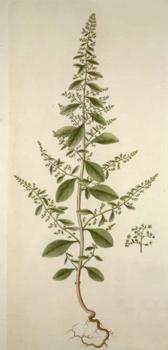Weeds
Chenopodium polyspermum - Manyseeded Goosefoot.
Systematic position.
Family Chenopodiaceae Vent., Genus Chenopodium L.Biological group.
Spring annual.Morphology and biology.
Polymorphic species. Plant is 10-100 cm in height, glabrous, with straight or ascending stem, branched from the base. Leaves are alternate, petiolate, oval or ovate-oblong, entire, round-cuneate at the base. From the top, first setof leaves are soot-green with violet shade, from the bottom they are bright violet-red. Hypocotyl is violet-red as well. As plant grows, bright violet-red colour disappears and is replaced by dark-green. Flowers are bisexual, divided into 5 parts. They are situated in both terminal and axillary verticillate-spikelike inflorescences. This plant flowers from July until September. Seeds are rounded, dark-brown, and lustrous. An individual plant can produce up to 100,000 seeds.Distribution.
Weed occurs across all of the European part of the former USSR except Far North, in Caucasus, in Western Siberia up to Lake Baikal, in Eastern Siberia as an adventitious plant. Generally distributed across Europe, Asia Minor, and North America.Ecology.
Euroasian adventitious weed species. Anthropochore, autochore. Chenopodium polyspermum is a segetal weed in tilled crops, in gardens and vegetable gardens. It is also found as a ruderal weed along sandy slopes of riversides and waterbasins, on roadsides, near houses, fences, and in rubbish dumps. This plant prefers rather wet but at the same time well-aerated soils. Seeds germinate in largest quantity when on soil surface or minimally covered with soil.Economic significance. Chenopodium polyspermum is especially harmful in vegetable gardens where its leafy, branched and low growing stems can quickly out-compete weak cultivated plants. In some regions young leaves and stems of this weed are used as a vegetable. It is of some importance in folk medicine. Its ash contains a lot of potash. Control measures: soil hoeing in vegetable gardens, soil treatment by special harrows in tilled crops.
Reference citations:
Keller B.A., ed. 1934. Weed plants of the USSR. Leningrad: Ac.Sc.USSR. V.2: 100-101.Komarov, V.L & B.K. Shishkin, ed. 1936. Flora of the USSR. Moscow-Leningrad: Ac.Sc.USSR. V.6: 48.
Korsmo E. 1933. Weed plants of modern farming. Moscow-Leningrad: Publishing House of Kolchoz & Sovchoz Literature. 91-92 pp.
Nikitin V.V. 1983. Weeds in the flora of the USSR. Leningrad: Nauka. 166 pp.
Ulyanova T.N. 1998. Weeds in the flora of Russia and other FSU states. Saint-Petersburg: VIR. 215 pp.


